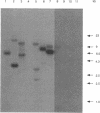Abstract
A cDNA clone encoding phenol hydroxylase from the soil yeast Trichosporon cutaneum was isolated and characterized. The clone was identified by hybridization screening of a bacteriophage lambda ZAP-based cDNA library with an oligonucleotide probe which corresponded to the N-terminal amino acid sequence of the purified enzyme. The cDNA encodes a protein consisting of 664 amino acids. Amino acid sequences of a number of peptides obtained by Edman degradation of various cleavage products of the purified enzyme were identified in the cDNA-derived sequence. The phenol hydroxylase cDNA was expressed in Escherichia coli to yield high levels of active enzyme. The E. coli-derived phenol hydroxylase is very similar to the T. cutaneum enzyme with respect to the range of substrates acted upon, inhibition by excess phenol, and the order of magnitude of kinetic parameters in the overall reaction. Southern blot analysis revealed the presence of phenol hydroxylase gene-related sequences in a number of T. cutaneum and Trichosporon beigelii strains and in Cryptococcus elinovii but not in Trichosporon pullulans, Trichosporon penicillatum, or Candida tropicalis.
Full text
PDF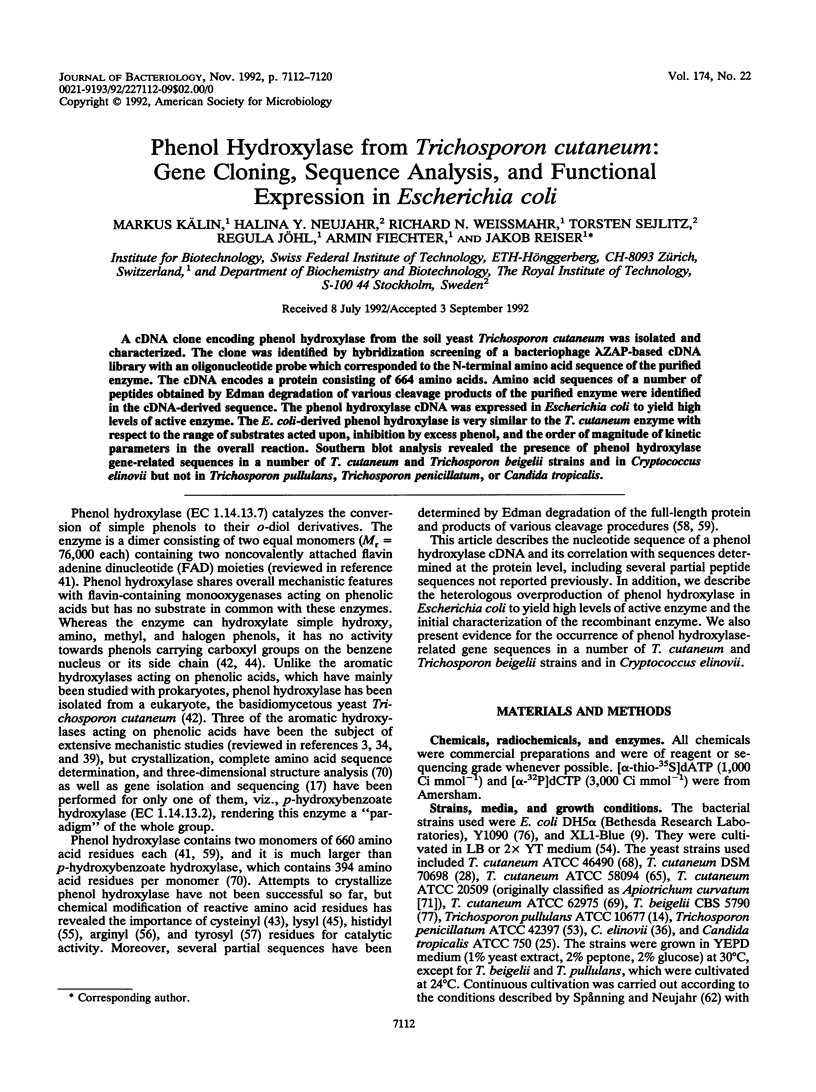
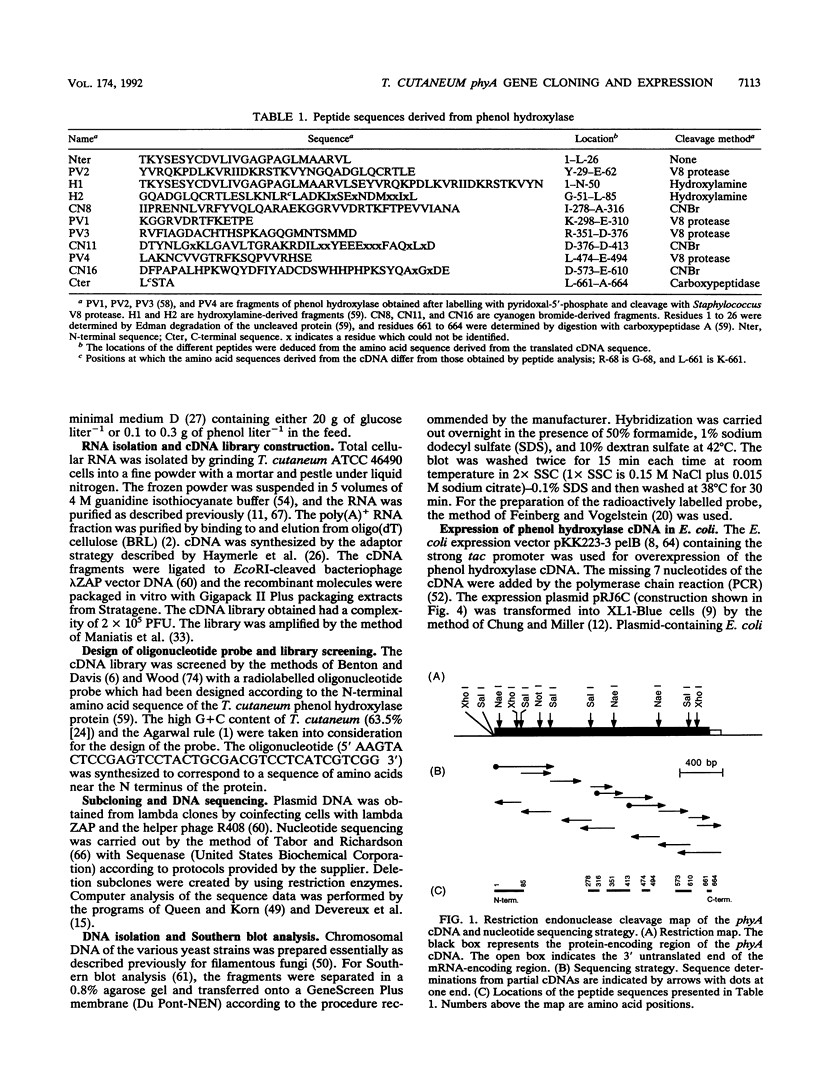
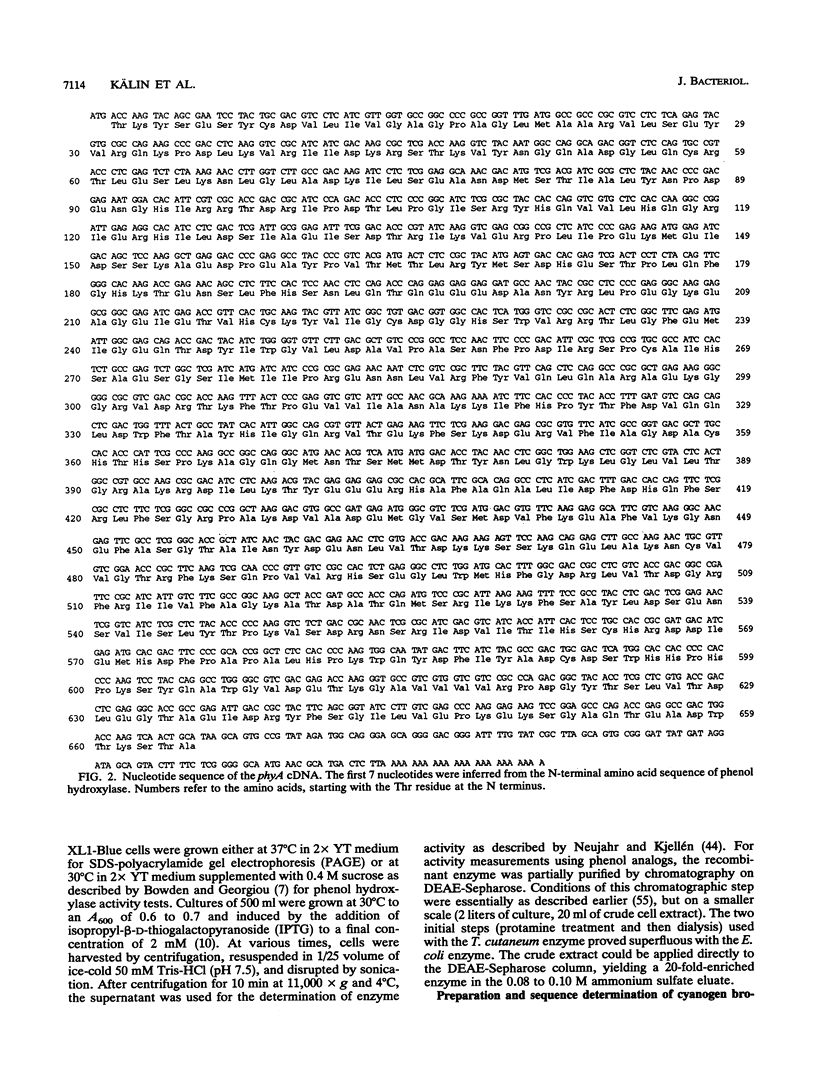
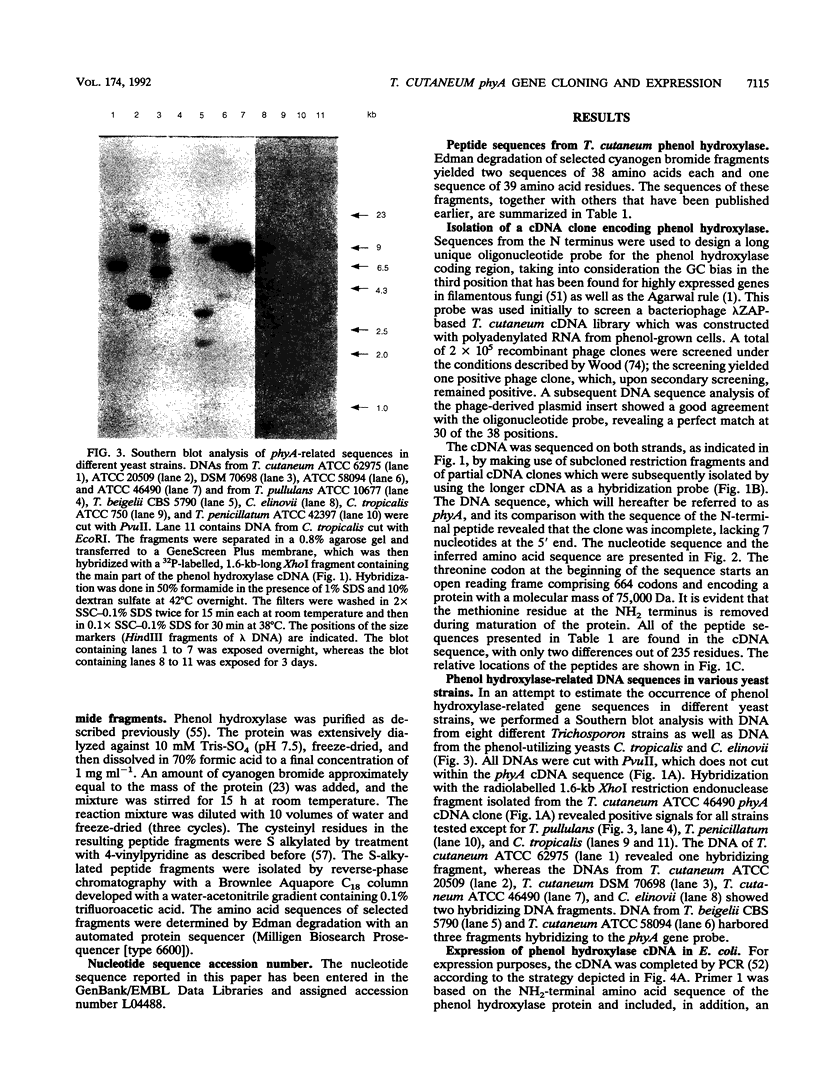

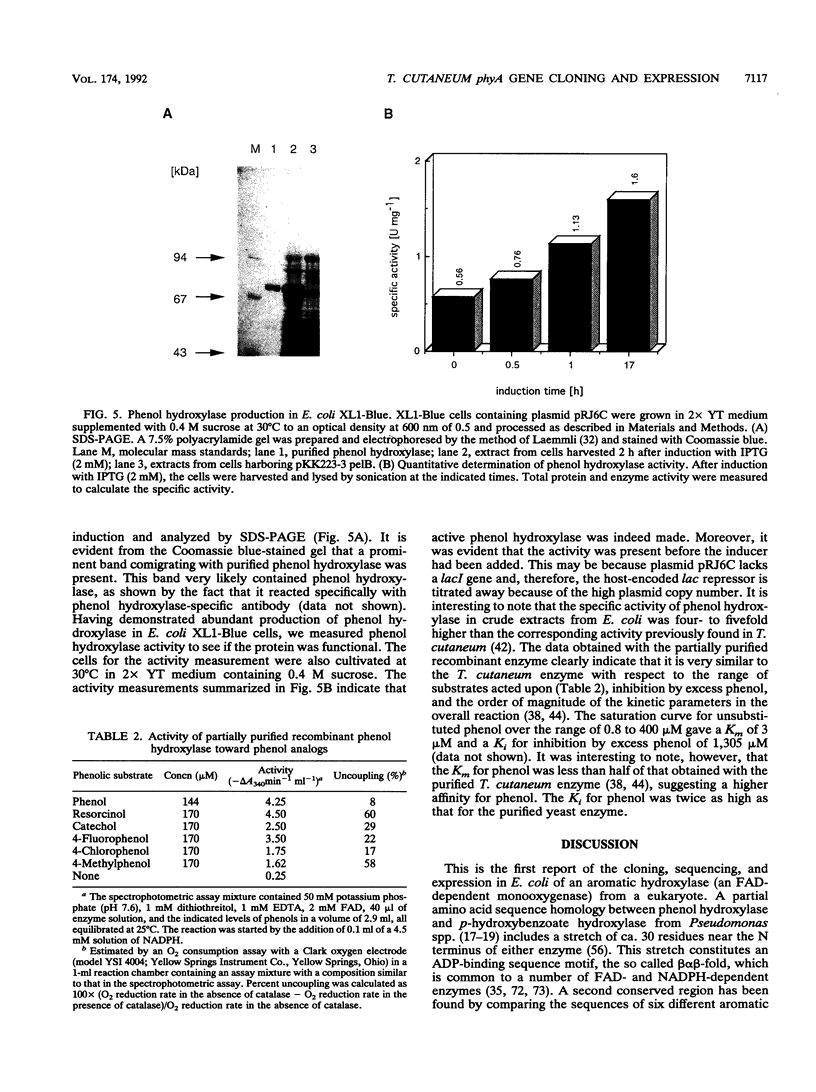
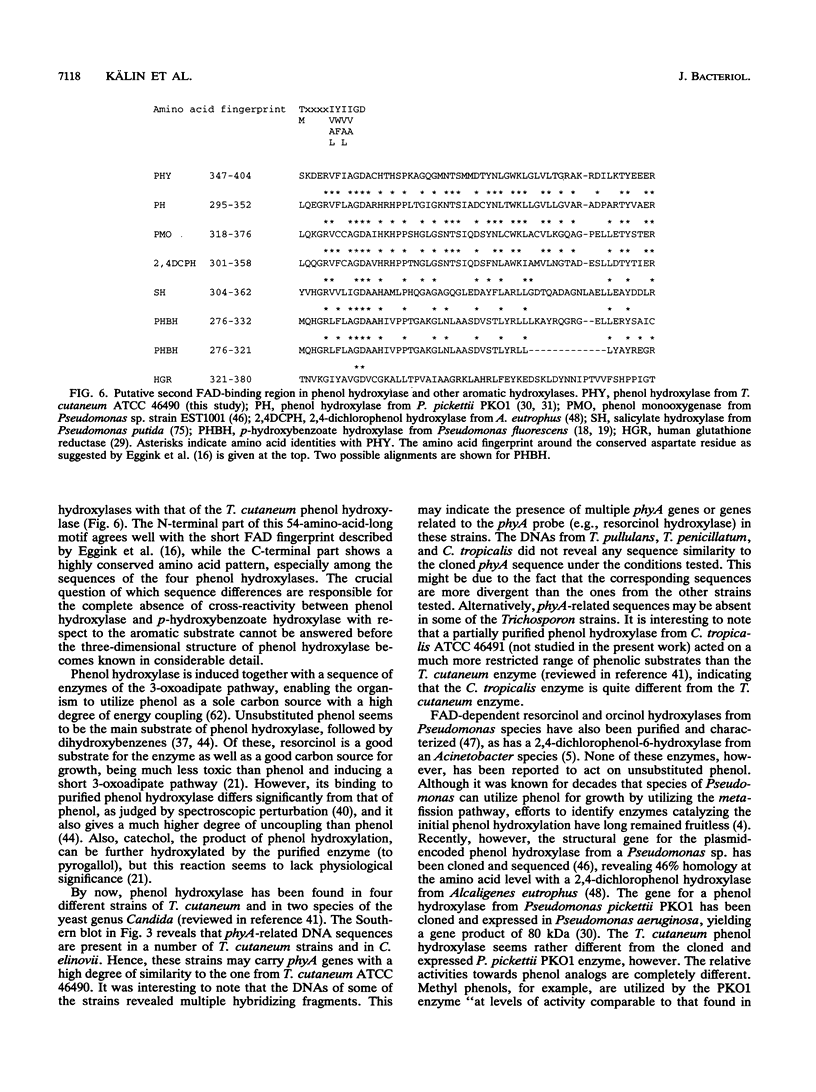
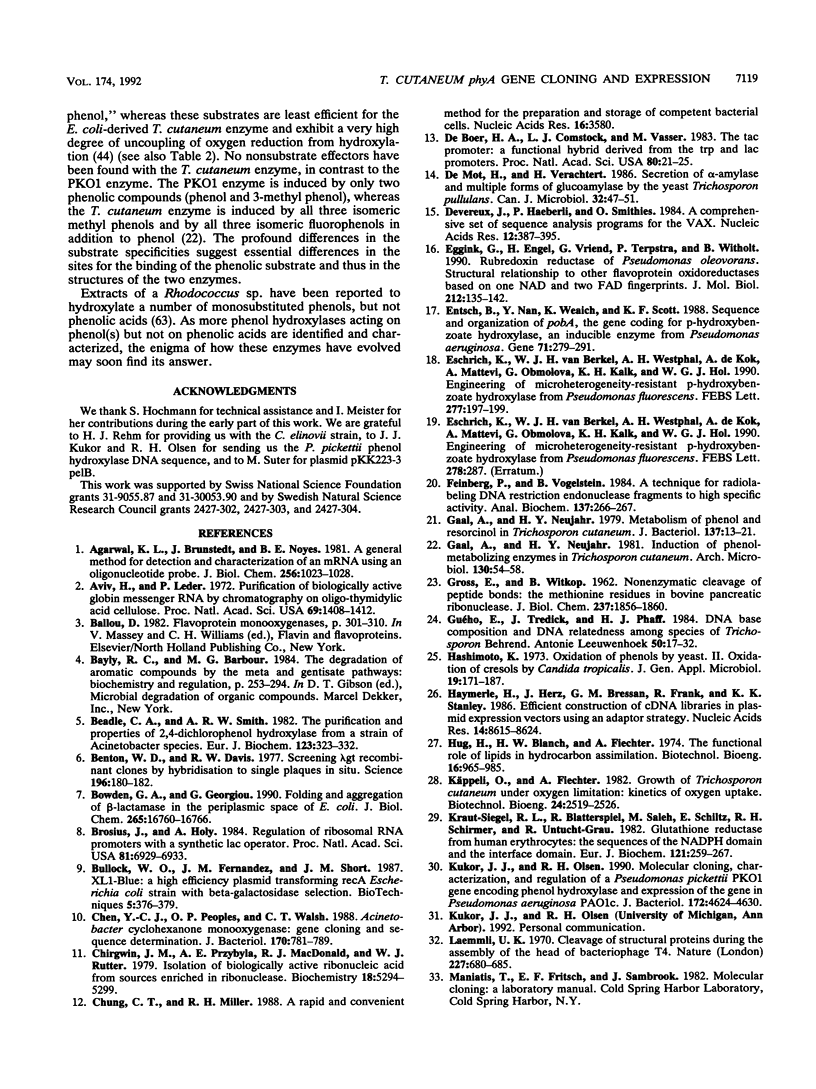
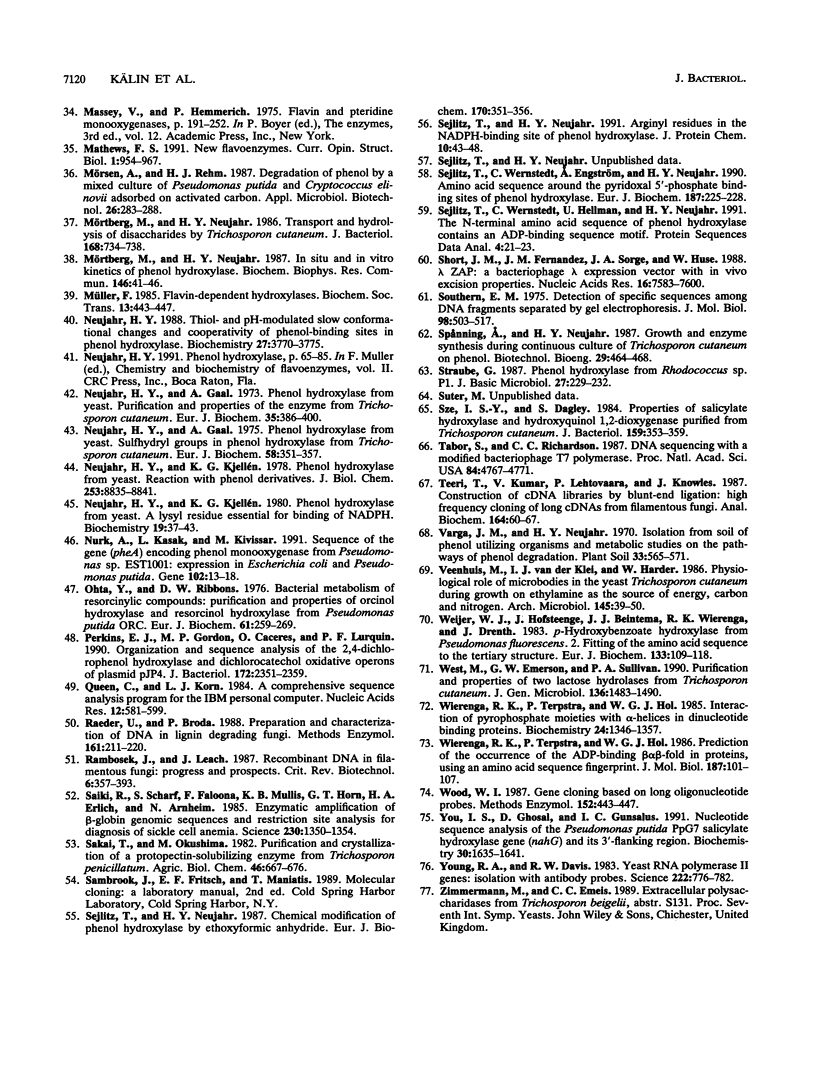
Images in this article
Selected References
These references are in PubMed. This may not be the complete list of references from this article.
- Agarwal K. L., Brunstedt J., Noyes B. E. A general method for detection and characterization of an mRNA using an oligonucleotide probe. J Biol Chem. 1981 Jan 25;256(2):1023–1028. [PubMed] [Google Scholar]
- Aviv H., Leder P. Purification of biologically active globin messenger RNA by chromatography on oligothymidylic acid-cellulose. Proc Natl Acad Sci U S A. 1972 Jun;69(6):1408–1412. doi: 10.1073/pnas.69.6.1408. [DOI] [PMC free article] [PubMed] [Google Scholar]
- Beadle C. A., Smith A. R. The purification and properties of 2,4-dichlorophenol hydroxylase from a strain of Acinetobacter species. Eur J Biochem. 1982 Apr 1;123(2):323–332. doi: 10.1111/j.1432-1033.1982.tb19771.x. [DOI] [PubMed] [Google Scholar]
- Benton W. D., Davis R. W. Screening lambdagt recombinant clones by hybridization to single plaques in situ. Science. 1977 Apr 8;196(4286):180–182. doi: 10.1126/science.322279. [DOI] [PubMed] [Google Scholar]
- Bowden G. A., Georgiou G. Folding and aggregation of beta-lactamase in the periplasmic space of Escherichia coli. J Biol Chem. 1990 Oct 5;265(28):16760–16766. [PubMed] [Google Scholar]
- Brosius J., Holy A. Regulation of ribosomal RNA promoters with a synthetic lac operator. Proc Natl Acad Sci U S A. 1984 Nov;81(22):6929–6933. doi: 10.1073/pnas.81.22.6929. [DOI] [PMC free article] [PubMed] [Google Scholar]
- Chen Y. C., Peoples O. P., Walsh C. T. Acinetobacter cyclohexanone monooxygenase: gene cloning and sequence determination. J Bacteriol. 1988 Feb;170(2):781–789. doi: 10.1128/jb.170.2.781-789.1988. [DOI] [PMC free article] [PubMed] [Google Scholar]
- Chirgwin J. M., Przybyla A. E., MacDonald R. J., Rutter W. J. Isolation of biologically active ribonucleic acid from sources enriched in ribonuclease. Biochemistry. 1979 Nov 27;18(24):5294–5299. doi: 10.1021/bi00591a005. [DOI] [PubMed] [Google Scholar]
- Chung C. T., Miller R. H. A rapid and convenient method for the preparation and storage of competent bacterial cells. Nucleic Acids Res. 1988 Apr 25;16(8):3580–3580. doi: 10.1093/nar/16.8.3580. [DOI] [PMC free article] [PubMed] [Google Scholar]
- De Mot R., Verachtert H. Secretion of alpha-amylase and multiple forms of glucoamylase by the yeast Trichosporon pullulans. Can J Microbiol. 1986 Jan;32(1):47–51. doi: 10.1139/m86-009. [DOI] [PubMed] [Google Scholar]
- Devereux J., Haeberli P., Smithies O. A comprehensive set of sequence analysis programs for the VAX. Nucleic Acids Res. 1984 Jan 11;12(1 Pt 1):387–395. doi: 10.1093/nar/12.1part1.387. [DOI] [PMC free article] [PubMed] [Google Scholar]
- Eggink G., Engel H., Vriend G., Terpstra P., Witholt B. Rubredoxin reductase of Pseudomonas oleovorans. Structural relationship to other flavoprotein oxidoreductases based on one NAD and two FAD fingerprints. J Mol Biol. 1990 Mar 5;212(1):135–142. doi: 10.1016/0022-2836(90)90310-I. [DOI] [PubMed] [Google Scholar]
- Entsch B., Nan Y., Weaich K., Scott K. F. Sequence and organization of pobA, the gene coding for p-hydroxybenzoate hydroxylase, an inducible enzyme from Pseudomonas aeruginosa. Gene. 1988 Nov 30;71(2):279–291. doi: 10.1016/0378-1119(88)90044-3. [DOI] [PubMed] [Google Scholar]
- Eschrich K., van Berkel W. J., Westphal A. H., de Kok A., Mattevi A., Obmolova G., Kalk K. H., Hol W. G. Engineering of microheterogeneity-resistant p-hydroxybenzoate hydroxylase from Pseudomonas fluorescens. FEBS Lett. 1990 Dec 17;277(1-2):197–199. doi: 10.1016/0014-5793(90)80843-8. [DOI] [PubMed] [Google Scholar]
- Feinberg A. P., Vogelstein B. "A technique for radiolabeling DNA restriction endonuclease fragments to high specific activity". Addendum. Anal Biochem. 1984 Feb;137(1):266–267. doi: 10.1016/0003-2697(84)90381-6. [DOI] [PubMed] [Google Scholar]
- GROSS E., WITKOP B. Nonenzymatic cleavage of peptide bonds: the methionine residues in bovine pancreatic ribonuclease. J Biol Chem. 1962 Jun;237:1856–1860. [PubMed] [Google Scholar]
- Gaal A., Neujahr H. Y. Induction of phenol-metabolizing enzymes in Trichosporon cutaneum. Arch Microbiol. 1981 Sep;130(1):54–58. doi: 10.1007/BF00527072. [DOI] [PubMed] [Google Scholar]
- Gaal A., Neujahr H. Y. Metabolism of phenol and resorcinol in Trichosporon cutaneum. J Bacteriol. 1979 Jan;137(1):13–21. doi: 10.1128/jb.137.1.13-21.1979. [DOI] [PMC free article] [PubMed] [Google Scholar]
- Guého E., Tredick J., Phaff H. J. DNA base composition and DNA relatedness among species of Trichosporon Behrend. Antonie Van Leeuwenhoek. 1984;50(1):17–32. doi: 10.1007/BF00404904. [DOI] [PubMed] [Google Scholar]
- Haymerle H., Herz J., Bressan G. M., Frank R., Stanley K. K. Efficient construction of cDNA libraries in plasmid expression vectors using an adaptor strategy. Nucleic Acids Res. 1986 Nov 11;14(21):8615–8624. doi: 10.1093/nar/14.21.8615. [DOI] [PMC free article] [PubMed] [Google Scholar]
- Hug H., Blanch H. W., Fiechter A. The functional role of lipids in hydrocarbon assimilation. Biotechnol Bioeng. 1974 Jul;16(7):965–985. doi: 10.1002/bit.260160709. [DOI] [PubMed] [Google Scholar]
- Krauth-Siegel R. L., Blatterspiel R., Saleh M., Schiltz E., Schirmer R. H., Untucht-Grau R. Glutathione reductase from human erythrocytes. The sequences of the NADPH domain and of the interface domain. Eur J Biochem. 1982 Jan;121(2):259–267. doi: 10.1111/j.1432-1033.1982.tb05780.x. [DOI] [PubMed] [Google Scholar]
- Kukor J. J., Olsen R. H. Molecular cloning, characterization, and regulation of a Pseudomonas pickettii PKO1 gene encoding phenol hydroxylase and expression of the gene in Pseudomonas aeruginosa PAO1c. J Bacteriol. 1990 Aug;172(8):4624–4630. doi: 10.1128/jb.172.8.4624-4630.1990. [DOI] [PMC free article] [PubMed] [Google Scholar]
- Laemmli U. K. Cleavage of structural proteins during the assembly of the head of bacteriophage T4. Nature. 1970 Aug 15;227(5259):680–685. doi: 10.1038/227680a0. [DOI] [PubMed] [Google Scholar]
- Mörtberg M., Neujahr H. Y. In situ and in vitro kinetics of phenol hydroxylase. Biochem Biophys Res Commun. 1987 Jul 15;146(1):41–46. doi: 10.1016/0006-291x(87)90687-5. [DOI] [PubMed] [Google Scholar]
- Mörtberg M., Neujahr H. Y. Transport and hydrolysis of disaccharides by Trichosporon cutaneum. J Bacteriol. 1986 Nov;168(2):734–738. doi: 10.1128/jb.168.2.734-738.1986. [DOI] [PMC free article] [PubMed] [Google Scholar]
- Müller F. Flavin-dependent hydroxylases. Biochem Soc Trans. 1985 Apr;13(2):443–447. doi: 10.1042/bst0130443. [DOI] [PubMed] [Google Scholar]
- Neujahr H. Y., Gaal A. Phenol hydroxylase from yeast. Purification and properties of the enzyme from Trichosporon cutaneum. Eur J Biochem. 1973 Jun;35(2):386–400. doi: 10.1111/j.1432-1033.1973.tb02851.x. [DOI] [PubMed] [Google Scholar]
- Neujahr H. Y., Gaal A. Phenol hydroxylase from yeast. Sulfhydryl groups in phenol hydroxylase from Trichosporon cutaneum. Eur J Biochem. 1975 Oct 15;58(2):351–357. doi: 10.1111/j.1432-1033.1975.tb02381.x. [DOI] [PubMed] [Google Scholar]
- Neujahr H. Y., Kjellén K. G. Phenol hydroxylase from yeast. Reaction with phenol derivatives. J Biol Chem. 1978 Dec 25;253(24):8835–8841. [PubMed] [Google Scholar]
- Neujahr H. Y. Thiol- and pH-modulated slow conformational changes and cooperativity of phenol-binding sites in phenol hydroxylase. Biochemistry. 1988 May 17;27(10):3770–3775. doi: 10.1021/bi00410a038. [DOI] [PubMed] [Google Scholar]
- Nurk A., Kasak L., Kivisaar M. Sequence of the gene (pheA) encoding phenol monooxygenase from Pseudomonas sp. EST1001: expression in Escherichia coli and Pseudomonas putida. Gene. 1991 Jun 15;102(1):13–18. doi: 10.1016/0378-1119(91)90531-f. [DOI] [PubMed] [Google Scholar]
- Ohta Y., Ribbons D. W. Bacterial metabolism of resorcinylic compounds: purification and properties of orcinol hydroxylase and resorcinol hydroxylase from Pseudomonas putida ORC. Eur J Biochem. 1976 Jan 2;61(1):259–269. doi: 10.1111/j.1432-1033.1976.tb10019.x. [DOI] [PubMed] [Google Scholar]
- Perkins E. J., Gordon M. P., Caceres O., Lurquin P. F. Organization and sequence analysis of the 2,4-dichlorophenol hydroxylase and dichlorocatechol oxidative operons of plasmid pJP4. J Bacteriol. 1990 May;172(5):2351–2359. doi: 10.1128/jb.172.5.2351-2359.1990. [DOI] [PMC free article] [PubMed] [Google Scholar]
- Queen C., Korn L. J. A comprehensive sequence analysis program for the IBM personal computer. Nucleic Acids Res. 1984 Jan 11;12(1 Pt 2):581–599. doi: 10.1093/nar/12.1part2.581. [DOI] [PMC free article] [PubMed] [Google Scholar]
- Rambosek J., Leach J. Recombinant DNA in filamentous fungi: progress and prospects. Crit Rev Biotechnol. 1987;6(4):357–393. doi: 10.3109/07388558709089387. [DOI] [PubMed] [Google Scholar]
- Saiki R. K., Scharf S., Faloona F., Mullis K. B., Horn G. T., Erlich H. A., Arnheim N. Enzymatic amplification of beta-globin genomic sequences and restriction site analysis for diagnosis of sickle cell anemia. Science. 1985 Dec 20;230(4732):1350–1354. doi: 10.1126/science.2999980. [DOI] [PubMed] [Google Scholar]
- Sejlitz T., Neujahr H. Y. Arginyl residues in the NADPH-binding sites of phenol hydroxylase. J Protein Chem. 1991 Feb;10(1):43–48. doi: 10.1007/BF01024654. [DOI] [PubMed] [Google Scholar]
- Sejlitz T., Neujahr H. Y. Chemical modification of phenol hydroxylase by ethoxyformic anhydride. Eur J Biochem. 1987 Dec 30;170(1-2):351–356. doi: 10.1111/j.1432-1033.1987.tb13706.x. [DOI] [PubMed] [Google Scholar]
- Sejlitz T., Wernstedt C., Engström A., Neujahr H. Y. Amino acid sequences around the pyridoxal-5'-phosphate-binding sites of phenol hydroxylase. Eur J Biochem. 1990 Jan 12;187(1):225–228. doi: 10.1111/j.1432-1033.1990.tb15298.x. [DOI] [PubMed] [Google Scholar]
- Sejlitz T., Wernstedt C., Hellman U., Neujahr H. Y. The N-terminal amino acid sequence of phenol hydroxylase contains a dinucleotide-binding sequence motif. Protein Seq Data Anal. 1991 Jul;4(1):21–23. [PubMed] [Google Scholar]
- Short J. M., Fernandez J. M., Sorge J. A., Huse W. D. Lambda ZAP: a bacteriophage lambda expression vector with in vivo excision properties. Nucleic Acids Res. 1988 Aug 11;16(15):7583–7600. doi: 10.1093/nar/16.15.7583. [DOI] [PMC free article] [PubMed] [Google Scholar]
- Southern E. M. Detection of specific sequences among DNA fragments separated by gel electrophoresis. J Mol Biol. 1975 Nov 5;98(3):503–517. doi: 10.1016/s0022-2836(75)80083-0. [DOI] [PubMed] [Google Scholar]
- Straube G. Phenol hydroxylase from Rhodococcus sp. P 1. J Basic Microbiol. 1987;27(4):229–232. doi: 10.1002/jobm.3620270415. [DOI] [PubMed] [Google Scholar]
- Sze I. S., Dagley S. Properties of salicylate hydroxylase and hydroxyquinol 1,2-dioxygenase purified from Trichosporon cutaneum. J Bacteriol. 1984 Jul;159(1):353–359. doi: 10.1128/jb.159.1.353-359.1984. [DOI] [PMC free article] [PubMed] [Google Scholar]
- Tabor S., Richardson C. C. DNA sequence analysis with a modified bacteriophage T7 DNA polymerase. Proc Natl Acad Sci U S A. 1987 Jul;84(14):4767–4771. doi: 10.1073/pnas.84.14.4767. [DOI] [PMC free article] [PubMed] [Google Scholar]
- Teeri T. T., Kumar V., Lehtovaara P., Knowles J. Construction of cDNA libraries by blunt-end ligation: high-frequency cloning of long cDNAs from filamentous fungi. Anal Biochem. 1987 Jul;164(1):60–67. doi: 10.1016/0003-2697(87)90367-8. [DOI] [PubMed] [Google Scholar]
- Weijer W. J., Hofsteenge J., Beintema J. J., Wierenga R. K., Drenth J. p-Hydroxybenzoate hydroxylase from Pseudomonas fluorescens. 2. Fitting of the amino-acid sequence to the tertiary structure. Eur J Biochem. 1983 Jun 1;133(1):109–118. doi: 10.1111/j.1432-1033.1983.tb07435.x. [DOI] [PubMed] [Google Scholar]
- West M., Emerson G. W., Sullivan P. A. Purification and properties of two lactose hydrolases from Trichosporon cutaneum. J Gen Microbiol. 1990 Aug;136(8):1483–1490. doi: 10.1099/00221287-136-8-1483. [DOI] [PubMed] [Google Scholar]
- Wierenga R. K., Terpstra P., Hol W. G. Prediction of the occurrence of the ADP-binding beta alpha beta-fold in proteins, using an amino acid sequence fingerprint. J Mol Biol. 1986 Jan 5;187(1):101–107. doi: 10.1016/0022-2836(86)90409-2. [DOI] [PubMed] [Google Scholar]
- Wood W. I. Gene cloning based on long oligonucleotide probes. Methods Enzymol. 1987;152:443–447. doi: 10.1016/0076-6879(87)52051-1. [DOI] [PubMed] [Google Scholar]
- You I. S., Ghosal D., Gunsalus I. C. Nucleotide sequence analysis of the Pseudomonas putida PpG7 salicylate hydroxylase gene (nahG) and its 3'-flanking region. Biochemistry. 1991 Feb 12;30(6):1635–1641. doi: 10.1021/bi00220a028. [DOI] [PubMed] [Google Scholar]
- Young R. A., Davis R. W. Yeast RNA polymerase II genes: isolation with antibody probes. Science. 1983 Nov 18;222(4625):778–782. doi: 10.1126/science.6356359. [DOI] [PubMed] [Google Scholar]
- de Boer H. A., Comstock L. J., Vasser M. The tac promoter: a functional hybrid derived from the trp and lac promoters. Proc Natl Acad Sci U S A. 1983 Jan;80(1):21–25. doi: 10.1073/pnas.80.1.21. [DOI] [PMC free article] [PubMed] [Google Scholar]



